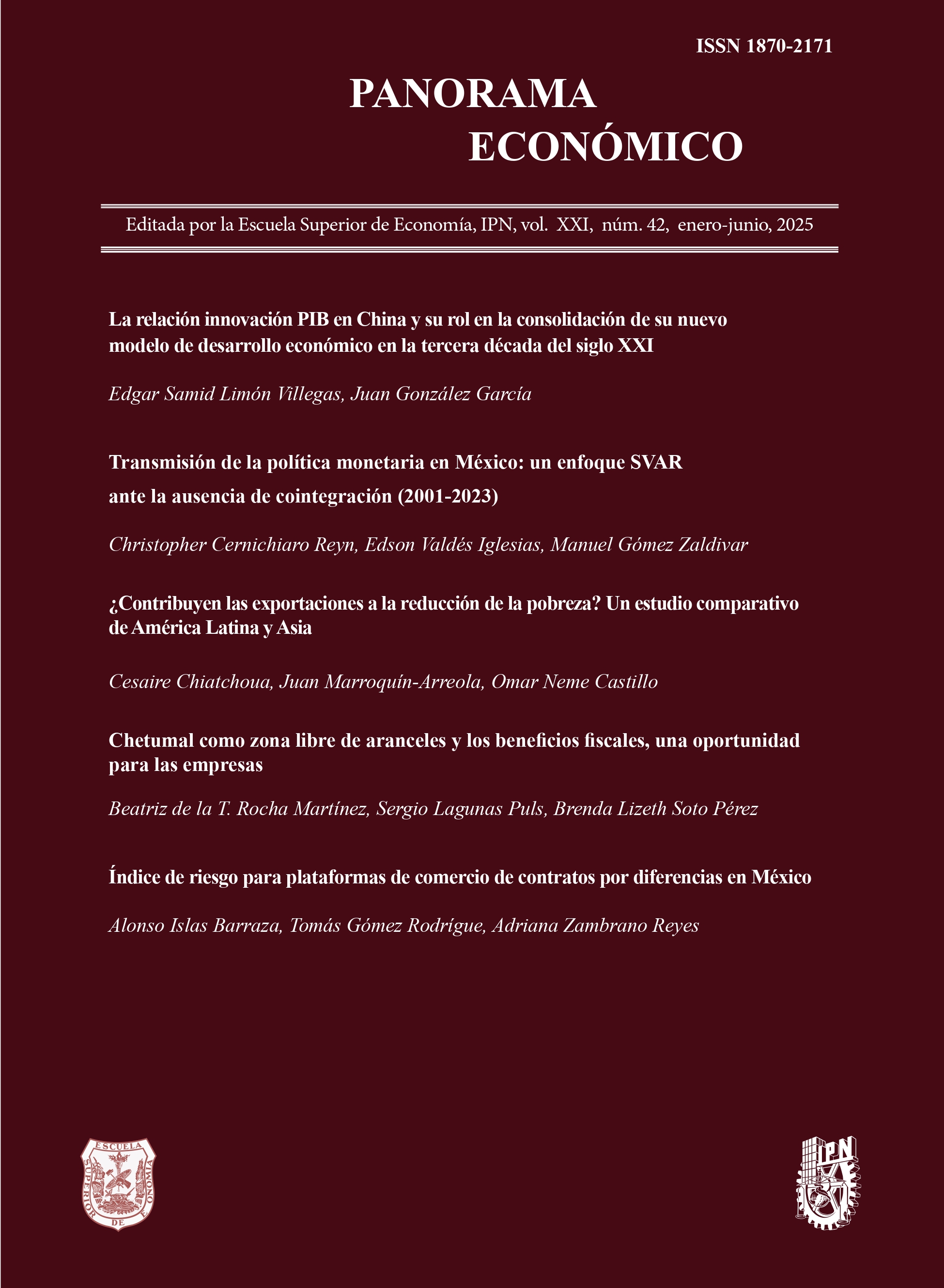¿Contribuyen las exportaciones a la reducción de la pobreza? Un estudio comparativo de América Latina y Asia
Contenido principal del artículo
El documento tiene como objetivo determinar el efecto de las exportaciones sobre la pobreza para un grupo de 68 países en el período 2009-2021. La muestra total se divide según la participación de cada país en las cadenas globales de valor como medida de integración en la economía internacional. El análisis se extiende a los casos de América Latina y Asia. Se utiliza una metodología econométrica de datos de panel dinámico (sys-GMM). Los re- sultados sugieren que las exportaciones contribuyen a reducir la pobreza media, extrema y moderada. El impacto es mayor en los países con menor integración comercial. Las exportaciones tienden a reducir la pobreza junto con niveles más altos de gasto público, educación y remesas. Finalmente, el efecto exportador es mayor para los países asiáticos. La agenda de desarro- llo debe complementarse con políticas comerciales que promuevan las ex- portaciones y la integración comercial, incorporando medidas que reduzcan la vulnerabilidad externa.
References
Aderounmu, B.; D. Azuh; O. Onanuga; O. Oluwatomisin; B. Ebenezer & A. Azuh (2021). Poverty drivers and Nigeria’s development: Implications for policy intervention. Co- gent Arts & Humanities, 8(1), 1927495. https://doi.org/10.1080/23311983.2021.1927495.
Alarco, G. (2017). Tratados de libre comercio, crecimiento y producto potencial en Chile, México y Perú. Economía UNAM, 14(42):24-46. https://doi.org/10.1016/j.eunam.2017.09.001.
Alvaredo, F. & L. Gasparini (2015). Recent Trends in Inequality and Poverty in Developing Countries. In Atkinson, A. y Bourguignon, F. (eds.) Handbook of Income Distribution. Elsevier: London. https://doi.org/10.1016/B978-0-444-59428-0.00010-2
Anderson, E.; M. Jalles; M. d’Orey; G. Duvendack & L. Esposito (2018). Does government spending affect income poverty? A meta-regression analysis. World Development, 103(C):60-71. https://doi.org/10.1016/j.worlddev.2017.10.006.
Anderson, J.; M. Larch & Y. Yotov (2019). Trade and investment in the global economy: A multi-country dynamic analysis. European Economic Review, 120. https:// doi.org/10.1016/j.euroecorev.2019.103311.
Ayoo, C. (2022). Poverty reduction strategies in developing countries. In: de Salvo, P. y Calvo, M. (eds.) Rural development. Education, sustainability, and multifunc- tionality. Intechopen: London. https://doi.org/10.5772/intechopen.101472.
Babatunde, A.; M. Oyeranti; A. Bakole & O. Ogunkola (2012). Exports trade, employment and poverty reduction in Nigeria. International Journal of Social Economics, 39(11):875-899. https://doi.org/10.1108/03068291211263916.
Banco Mundial (2020). World Development Report 2020. Trading for development in the age of Global Value Chains. The World Bank: Washington, DC.
Berg, A. & Krueger, A. (2003). Trade, growth, and poverty: A selective survey. IMF Working Paper WP/03/30. https://doi.org/10.5089/9781451844931.001.
Bergstrom, K. (2022). The role of income inequality for poverty reduction. The World Bank Economic Review, 36(3):583-604. https://doi.org/10.1093/wber/lhab026.
Bird, K.; B. Chabé & A. Simons (2022). Linking human capabilities with livelihood strategies to speed poverty reduction: Evidence from Rwanda. World Develop- ment, 151. https://doi.org/10.1016/j.worlddev.2021.105728.
Biswas, R. & A. Sindzingre (2006). Trade openess, poverty and inequality in India: Literature and empirics at the sub-national level. The Indian Economy in the Era of Financial Globalisation: Paris.
Blau, B. (2018). Income inequality, poverty, and the liquidity of stock markets. Journal of Development Economics, 130:113-126. https://doi.org/10.1016/j.jdeveco.2017.10.006.
Blundell, R. & S. Bond (1998). Initial conditions and moment restrictions in dynamic panel data models. Journal of Econometrics, 87:115-143. https://doi.org/10.1016/ S0304-4076(98)00009-8.
Blundell, R.; S. Bond & F. Windmeijer (2000). Estimation in dynamic panel data models: Improving on the performance of the standard GMM estimator. In Bal- tagi, B. (ed.) Nonstationary panels, panel cointegration, and dynamic panels. advances in econometrics. JAI Press: Nueva York. https://doi.org/10.1920/wp.ifs.2000.0012.
Borin, A.; M. Mancini & D. Taglioni (2021). Countries and sector in GVCs. The World Bank Policy Research Working Paper, No. 9785.
Bun, M. & Windmeijer, F. (2007). The weak instrument problem the sys-GMM estimator in dynamic panel data models. University of Bristol Economics Working Paper, no. 07/595. https://doi.org/10.1920/wp.cem.2007.0807.
Chiatchoua, C.; V. García & O. Neme (2022). Contribución de las exportaciones en la reducción de la pobreza en México, 2008-2018. Análisis Económico, 37(96):61-77. https://doi.org/10.24275/uam/azc/dcsh/ae/2022v37n96/Chiatchoua.
CUTS International (2008). Trade-development-poverty linkages: Reflections from selected Asian and Sub-Saharan Africa countries. Country case studies. CUTS International: Jaipur.
De Hoyos, R. & E. Lusting (2017). Apertura comercial, desigualdad y pobreza. Reseña de los enfoques metodológicos, el estado del conocimiento y la asignatura pendiente. El Trimestre Económico, 2(302):283-328. https://doi.org/10.20430/ete.v76i302.484.
Deb, P.; J. Flores; S. Kothari & N. Tawk (2021). How trade can help speed Asia´s economic recovery. IMF Blog. https://www.imf.org/en/Blogs/Articles/2021/11/19/blog-how- trade-can-help-speed-asias-economic-recovery.
Demirgüç, A.; L. Klapper; D. Singer; S. Ansar & J. Hess (2018). The Global Fin- dex Database 2017: measuring financial inclusion and the fintech revolution. World Bank, Washington, DC.
Desalegn, A. & N. Solomon (2020). Infrastructure inequities and its effect on poverty reduction across regional states in Ethiopia. Journal of Mega Infras- tructure & Sustainable Development, 2(3): 291-309. https://doi.org/10.1080/2472 4718.2022.2122671.
Dollar, D. & A. Kraay (2004). Growth is good for the poor. Policy Research Working Paper Series 2587. The World Bank Development Research Group: Washington, DC. https://doi.org/10.1093/0199268657.003.0002.
Erlando, A.; F. Riyanto & S. Masakazu (2020). Financial inclusion, economic growth, and poverty alleviation: Evidence from eastern Indonesia. Heliyon, 6(10):1-13. https:// doi.org/10.1016/j.heliyon.2020.e05235.
Fabrizi, E. & C. Mussida (2020). Assessing poverty persistence in households with children. Journal of Economic Inequality, 18:551-569. https://doi.org/10.1007/ s10888-020-09455-6.
Florennica, E. & R. Febriani (2022). Do financial deepening, government spending, and unemployment benefit poverty reduction in Indonesia? Journal Ekonomi Pembangunan, 20(2):193-204. https://doi.org/10.29259/jep.v20i2.18610.
Gammadigbe, V. (2021). Is Regional Trade Integration a Growth and Convergence Engine in Africa? IMF Working Paper WP/21/19. https://doi.org/10.5089/9781513567716.001.
Guerineau, S. (2016). Integration and Poverty Reduction. In Kireyev, A. (ed) Building integrated economies in West Africa. Lessons in managing Growth, Inclu- siveness, and volatility: International Monetary Fund: Washington.
Hayashikawa, M. (2009). Trading out of poverty: How aid for trade can help. OECD
Journal on Development, 10(2):1-38.
Hernández, R.; J. Martínez & P. Nanno (2014). Global value chains and world trade Prospects and challenges for Latin America. Economic Commission for Latin Ame- rica and the Caribbean: Santiago.
Hvidt, M.; T. Jeppesen; C. Gjødesen & J. van Biesebroeck (2015). Export Performance and Poverty Reduction, vol. II. European Commission: Belgium.
Imai, K.S.; R. Gaiha; A. Ali & N. Kaicker (2014). Remittances, growth and poverty: New evidence from Asian countries. Journal of Policy Modelling, 36 (3), 524-538. https://doi.org/10.1016/j.jpolmod.2014.01.009.
Isidro, V. (2016). The persistence of poverty in capitalist countries. Economía Informa, 400:67-82. https://doi.org/10.1016/j.ecin.2016.09.005.
Islam, M.; Z. Li & F. Fatema (2017). The effects of trade on poverty: Does sectoral composition of trade matter? Evidence from emerging economies. Journal of Eco- nomics and Economic Education Research, 18(3).
Jamal, H. (2006). Does inequality matter for poverty reduction? Evidence from Pakistan’s poverty trends. The Pakistan Development Review, 45(3), 439-459.
Justino, P.; J. Litchfield & H. Thai (2008). Poverty dynamics during trade reform: evidence from rural Vietnam. Review of Income and Wealth, 54(2):166-192. https:// doi.org/10.1111/j.1475-4991.2008.00269.
Kalaidi, A. & T. Chamberlain (2020). Exports and Economic Growth: Some Evidence from the GCC. International Advances in Economic Research, 26:203-205. https:// doi.org/10.1007/s11294-020-09786-0.
Kimm, S. (2019). Does multilateral trade liberalisation help reduce poverty in developing countries? Oxford Development Studies, 47(4):435-451. https://doi.org/10.10 80/13600818.2019.1612866.
Kimm, S. (2023). Export product concentration and poverty volatility in developing countries. The Journal International Trade. Published on line.
Lakner, C.; D. Mahler; M. Negre & E. Beer (2022). How much does reducing inequality matter for global poverty? Journal of Economic Inequality, 20:559-585. https:// doi.org/10.1007/s10888-021-09510-w.
Lawal, A.; E. Adegun; T. Aderemi & R. Dauda (2022). Migrant remittances, growth and poverty reduction: ARDL-bounds test and granger causality approach. Izves- tiya Journal of Varna University of Economics, 1(2):74-90. https://doi.org/10.56065/ IJUEV2022.66.1-2.74.
Lee, J.; G. Gereffi & S. Barrientos (2011). Global value chains, upgrading and poverty reduction. Capturing the Gains Briefing Notes 3, Manchester University. https:// doi.org/10.2139/ssrn.1990232
Lwesya, F. (2018). Export diversification and poverty reduction in Tanzania. The Romanian Economic Journal, 21(68):93-110.
Ma, S. (2022). Growth effects of economic integration: New evidence from the Belt and Road Initiative. Economic Analysis and Policy, 73:753-767. https://doi.or- g/10.1016/j.eap.2022.01.004.
Maertens, M. & F. Swinnen (2006). Trade, standards, and poverty: Evidence from Senegal. In LICOS Discussion Paper: 177/2006. https://doi.org/10.2139/ssrn.950485.
Menon, J. & A. Melendez (2020). When Does Trade Reduce Poverty? Revisiting the Evidence for East Asia. ISEAS Economics Working Paper 2020-04.
Morley, S. & C. Díaz (2006). Who gains from free trade? Export-led growth, inequality andpoverty in Latin America. In R. Vos, R., Ganuza, E, Morley, S. and Robinson, S. (eds.) Who gains from free trade. Routledge: London.
Neaime, S. & I. Gaysset (2018). Financial inclusion and stability in MENA: Evidence from poverty and inequality. Finance Research Letters, 24:230-237. https://doi. org/10.1016/j.frl.2017.09.007.
Oh, S. & L. Hyeon (2017). Does trade contribute to poverty reduction? If it does, where the benefit goes to? Annual Meeting Southern Agricultural Economics Asso- ciation: Mobile.
Osemenshan, F.; E. Esho, & G. Verhoef (2020). The impact of foreign direct invest- ment, foreign aid and trade on poverty reduction: Evidence from Sub-Saharan African countries. Cogent Economics & Finance, 8(1). https://doi.org/10.1080/2332 2039.2020.1737347.
Oyedele, O. & U. Eddy (2013). Export growth and poverty reduction in Nigeria. IOSR Journal of Humanities and Social Science, 16(3):48-52. https://doi. org/10.9790/0837-1634852.
OXFAM (2002). Cambiar las reglas. Comercio, globalización y lucha contra la pobreza. Aportes, 7(21):199-215.
Pangestu, M. (2022). Foreword. En Brenton, P., Ferrantino, M. y Maliszewska, M. (eds.) Reshaping Global Value Chains in light of Covid-19: Implications for trade and poverty reduction in developing countries. Banco Mundial: Washington, DC.
Patlán, J. & D. Navarrete (2009). La integración vertical como factor de competi- tividad en la industria textil y del vestido en México. Revista La Nueva Gestión Organizacional, 9:34-53.
Porto, G. (2010). International market access and poverty in Argentina. Review of International Economics, 18(2):396-407. https://doi.org/10.1111/j.1467-9396.2010.00875.
Raghutla, C. (2022). The effect of trade openness on economic growth: Some empirical evidence from emerging market economies. Public Affairs, 20(3):1-8. https:// doi.org/10.1002/pa.2081.
Rehman, A.; L. Cismas & I. Milin (2022). The Three Evils: Inflation, poverty and unemployment’s shadow on economic progress. A novel exploration from the asymmetric technique. Sustainability, 14. https://doi.org/10.3390/su14148642.
Rodríguez, C.; E. Vázquez & H. Winkler (2020). Tracing the local impacts of exports on poverty and inequality in Mexico. World Bank Policy Research Working Papers, 12/2020. https://doi.org/10.1596/1813-9450-9459.
Rodrik, D. (2006). What’s so special about China’s exports? China & World Economy, 14(5):1-19. https://doi.org/10.1111/j.1749-124X.2006.00038.
Roodman, D. (2006) How to do Xtabond2: An introduction to Difference and system GMM in Stata. The Stata Journal, 9:86-136. https://doi.or- g/10.1177/1536867X0900900106.
Sala-i-Martin, X. (2007). Economic Integration, Growth, and Poverty. Integra- tion and Trade Policy Issues Paper. Inter-American Development Bank. doi. org/10.18235/0009175. https://doi.org/10.18235/0009175.
Santos, A. (2017) Estimating the impact of trade specialization and trade policy on poverty in developing countries. The Journal of International Trade & Economic Development, 26:6, 693-711. https://doi.org/10.1080/09638199.2017.1291710.
Santos, A. & D. Thornquist (2015). Estimating the impact of trade specialization and trade policy on poverty in developing countries. Trade and Poverty Series ALDC/2015/6.
Santos, M.; Dabus, C. & F. Delbianco (2019). Growth and poverty revisited from a multidimensional perspective. Journal of Development Studies, 55(2):260-277. https://doi.org/10.1080/00220388.2017.1393520.
Selwyn, B. (2023). Why global value chains should be called global poverty chains. Developing Economies. https://developingeconomics.org/2023/01/13/why-global- value-chains-should-be-called-global-poverty-chains/.
Singh, T. (2010). Does international trade cause economic growth? A survey. The World Economy, 33(11):1517-1564. https://doi.org/10.1111/j.1467-9701.2010.01243.
Sposi, M.; KM. Yi & J. Zhang (2021). Trade Integration, Global Value Chains, and Capital Accumulation. IMF Econ Rev 69, 505-539. https://doi.org/10.1057/s41308- 021-00141-9.
Teichler, U. (2015). Education and employment. En Wright, J. (ed.) International Encyclopedia of the Social & Behavioral Sciences. Elsevier: Amsterdam. https:// doi.org/10.1016/B978-0-08-097086-8.92059-2.
UNCTAD (2016). The impact of trade on employment and poverty reduction. Conferencia de Las Naciones Unidas Sobre Comercio y Desarrollo: Ginebra.
Van den Broeck, G.; J. Swinnen & M. Maertens (2017). Global value chains, large scale farming, and poverty: Long-term effects in Senegal. Food Policy, 66:97107. https://doi.org/10.1016/j.foodpol.2016.12.003.
Wade, R. (2004). Is Globalization reducing poverty and inequality? International Journal of Health Services, 34(3):381-414. https://doi.org/10.2190/G8F1-01FL- MEDW-JVG1.
Wei, W. (2016). Achieving inclusive growth in China through vertical specialization. Elsevier: Cambridge.
Were, M. (2015). Differential effects of trade on economic growth and investment: A cross-country empirical investigation. Journal of African Trade. 2(1–2):71-85. ht- tps://doi.org/10.1016/j.joat.2015.08.002.
Windmeijer, F. (2005). A finite sample correction for the variance of linear efficient two-step GMM estimators. Journal of Econometrics, 126(1):25-51. https://doi.or- g/10.1016/j.jeconom.2004.02.005.
Xiao, H.; X. Zheng & L. Xie (2022). Promoting pro-poor growth through infrastructu- re investment: Evidence from the targeted poverty alleviation program in China. China Economic Review, 71:101729. https://doi.org/10.1016/j.chieco.2021.101729.
Yoshino, N., Taghizadeh, F. & Otsuka, M. (2017). International remittances and poverty reduction: Evidence from Asian developing countries. ADBI Working Paper Series, 759. Asian Development Bank Institute.
Yu, M. (2019). Trade openness and China´s economic development. Routledge: London.
Yusri, A. (2022). Does Government Expenditure Affect Poverty, Health, and Education? Evidence from Aceh, Indonesia. The Indonesian Journal of Development Plan- ning, 6(1): 1-20. https://doi.org/10.36574/jpp.v6i1.249.
Zhou, Y. & H. Huang (2023). Geo-environmental and socioeconomic determinants of poverty in China: an empirical analysis based on stratified poverty theory. En- vironmental Science and Pollution Research, 30:23836-23850. https://doi.org/10.1007/ s11356-022-23839-3
Zhang, T., Zhang, Y., Wan, G. & Wu, H. (2020). Poverty reduction in China and India: A comparative study. The Singapore Economic Review, 65(1):95-115. ht- tps://doi.org/10.1142/S0217590820440026
Detalles del artículo

Esta obra está bajo una licencia internacional Creative Commons Atribución-NoComercial-SinDerivadas 4.0.







